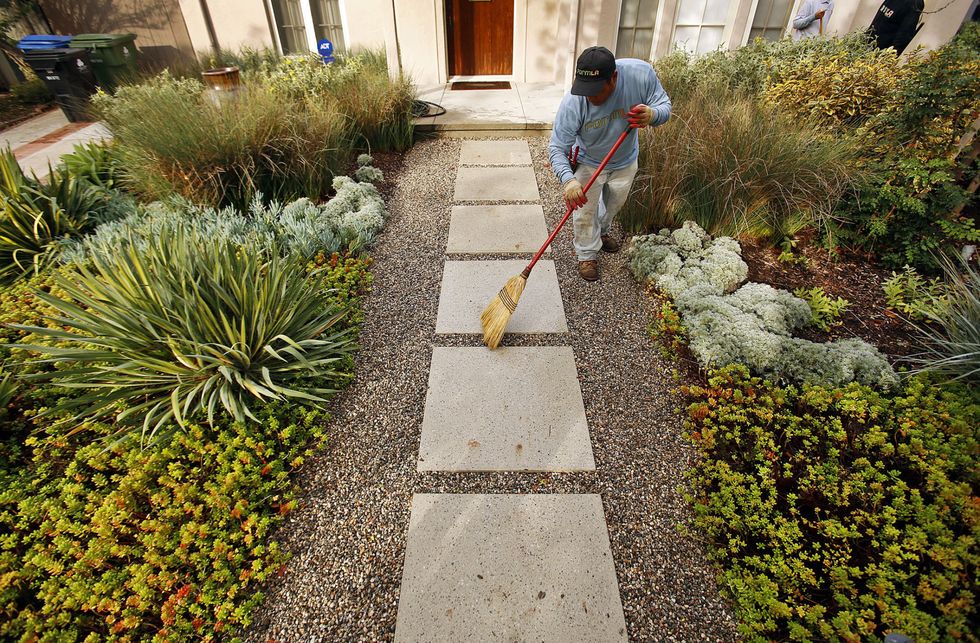Why Picking the Right Palm Desert Landscaping Service Matters
A Comprehensive Guide to Designing and Implementing Effective Landscape Design Solutions
The art and scientific research of landscaping prolong beyond simple aesthetic appeals; they entail a thoughtful assimilation of design concepts, environmental stewardship, and functional application. What approaches can one use to guarantee these landscapes not just flourish however additionally flourish in consistency with their environments?

Comprehending Landscape Design Concepts
One may wonder what fundamental aspects contribute to reliable landscape design. At its core, effective landscape style rests on numerous essential concepts that guide the setup and selection of components within an area. These principles consist of unity, balance, rhythm, and percentage, each offering to create an unified outside atmosphere.
Unity describes the cohesive relationship amongst various elements, guaranteeing that they interact aesthetically and functionally. Equilibrium can be accomplished through asymmetrical or balanced plans, permitting the landscape to feel steady and inviting. Percentage includes comprehending the scale of elements in connection with each various other and the surrounding atmosphere, advertising aesthetic consistency and comfort.

Assessing Your Outdoor Area
Before applying the principles of landscape style, a comprehensive analysis of your outdoor area is essential. This first analysis helps define the scope of your landscape design task and makes certain that your style lines up with the unique qualities of your residential property. Begin by examining the dimensions of your room, taking specific measurements to understand the offered area for different components such as pathways, patios, and gardens.
Next, observe the existing features of your landscape, including topography, soil quality, and drainage patterns. These factors considerably influence plant selection and placement. In addition, assess the sunlight direct exposure throughout different areas throughout the day, as this will influence the sorts of plants that grow in your yard.
Take into consideration the microclimates produced by structures, trees, and other obstacles, as they can affect temperature and dampness levels. Finally, make note of any kind of existing plants or hardscape aspects that you want to get rid of or preserve. This thorough examination lays the groundwork for a efficient and well-informed landscape design option, making sure that your design is not just visually pleasing but also useful and sustainable for several years to find.
Lasting Landscaping Techniques
These methods not just advertise ecological equilibrium but likewise boost the functional and visual worth of a landscape. Implementing reliable watering systems, such as drip irrigation, decreases water our website waste and ensures that plants get appropriate moisture (Palm Desert Landscaping).

Another reliable technique is the calculated placement of hedges and trees to offer all-natural windbreaks and shade, therefore lowering power prices (Palm Desert Landscaping). Rain gardens can be incorporated right into the landscape design to handle stormwater drainage efficiently, filtering toxins before they get in rivers
Picking the Right Plants
Selecting the right plants for your landscape is essential to attaining both aesthetic appeal and environmental consistency. The procedure starts with an understanding of your neighborhood climate, soil conditions, and the particular microenvironments within your landscape. Examining variables such as sunshine exposure, moisture levels, and existing flora will assist you select plants that prosper in your one-of-a-kind setup.
Take into consideration including indigenous plants, as they are well-adapted to neighborhood problems, call for much less upkeep, and assistance neighborhood wild animals. In addition, picking additional hints a varied selection of varieties can enhance biodiversity while reducing the risk of condition and parasite episodes. It is vital to examine the growth practices, blooming periods, and seasonal shades of possible plants to develop a natural and dynamic landscape.
Furthermore, consider the planned usage of the area; for example, if the area will certainly experience high foot website traffic, go with resilient ground covers. By thoughtfully choosing plants that straighten with both your ecological requirements and aesthetic objectives, you can produce a sustainable landscape that not only boosts your property yet likewise contributes favorably to the surrounding ecosystem.

Execution and Maintenance Methods
As soon as the best plants have actually been picked for your landscape, the focus shifts to efficient execution and ongoing maintenance methods. Effective installation begins with appropriate website preparation, which includes dirt screening to determine nutrient degrees and pH, adhered to by amending the soil as required. Carefully set up plants according to their development habits and light demands, ensuring sufficient spacing to advertise healthy growth.
Watering is a crucial aspect of application. Develop a watering timetable that takes into consideration the particular requirements of each plant varieties, adjusting for seasonal adjustments. Using visit this page drip watering systems can boost water effectiveness and decrease overflow.
Upkeep methods must be executed to guarantee the durability and vitality of your landscape. Routine tasks include weeding, mulching, and pruning to manage development and protect against condition. Fertilization should be carried out based upon dirt tests, providing the essential nutrients without over-fertilizing.
Keeping track of for parasites and conditions is essential; early discovery can prevent considerable damages. Seasonal adjustments to upkeep routines, such as winterizing perennials and preparing for spring development, will certainly ensure that your landscape remains healthy and balanced and visually attractive year-round.
Verdict
Effective execution and recurring maintenance further make certain the durability and vitality of landscapes. By integrating these aspects, landscapes can be changed right into beautiful, practical atmospheres that advertise biodiversity and add favorably to area well-being.
One may question what fundamental components add to reliable landscape design. At its core, successful landscape design hinges on a number of crucial concepts that assist the setup and option of elements within a space.Selecting the right plants for your landscape is essential to accomplishing both visual charm and environmental consistency. It is important to review the development behaviors, growing durations, and seasonal shades of possible plants to develop a dynamic and cohesive landscape.
Once the right plants have been picked for your landscape, the emphasis changes to efficient application and continuous maintenance strategies.